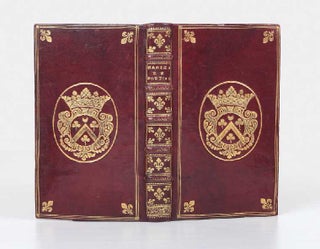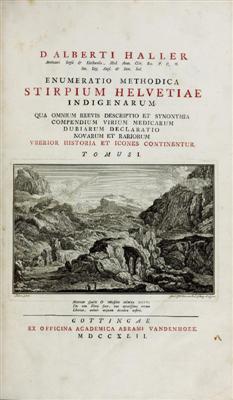Chronology of the Japanese & Chinese Emperors
Shisho wakan gounzu or Shisho wakan koto hennen gounzu [A Chronology of Japanese and Chinese History].
Woodblock printed. 67; 46; 46 folding leaves. Three vols. Large 8vo (283 x 192 mm.), orig. blue brocade design paper wrappers (slight worming carefully restored), orig. block-printed title label on upper cover of Vol. I (label partly missing), new stitching. [Japan]: ca. 1645.
First edition and very rare; this book is based on the Jusen wakan koto hennen gounzu (ca. 1611) by Nichisei (or Nichisho or Enchi, 1554-1614), a priest at the Yohoji Temple in Kyoto, where they printed “a series of important books…between 1600 and 1614” (Chibbett) with movable types. Nichisei supervised the temple’s printing program and also wrote and edited most of the works himself. Chronology was used in this work to legitimize the ruling families and dynasties and to provide a historical context and memory.
Yoshida (1598-1672), a member of a prominent family of physicians and engineers, is most famous for his Jinko-ki (1st ed.: 1627 and many later eds.), “the first great work on arithmetic to appear in Japan.”–Smith, History of Mathematics, Vol. I, p. 437. It explains operations on the soroban (abacus), including square and cube root. It has some interesting applications and gives 3.16 for the value of pi. In one of his later editions Yoshida appended a number of advanced problems to be solved by competitors. This procedure of issuing problems started among the Japanese and was kept up until 1813 and helped to stimulate mathematical activity.
Yoshida’s mathematical skills and knowledge of Chinese made him uniquely prepared to compile the present chronological work. The first volume begins with a genealogical table of the emperors of Japan, beginning with Jimmu in the 7th century B.C. through the 110th (misnumbered 111), Go-Komyo (reigned 1643-54). It bears the stamp of Yoshida. This is followed by three leaves describing the gods from which Jimmu descended. Following this are biographical sketches of each Japanese emperor up through Gomizunoo. Then there are tables listing the gods and emperors of both Japan (on top of the page) and China (on the lower half).
The final section of Vol. I and the second and third volumes provide a detailed account of the events from the beginnings of both Japanese and Chinese history up to 1645 in parallel texts.
Very nice set from the library of Donald and Mary Hyde (their sale, Christie’s NYC, 7 October 1988, lot 94). Preserved in a box.
❧ Cajori, A History of Mathematics, pp. 78-79. Chibbett, The History of Japanese Printing and Book Illustration, p. 72. Smith & Mikami, A History of Japanese Mathematics, pp. 59-62. Sugimoto & Swain, Science & Culture in Traditional Japan, pp. 263-64.
Price: $15,000.00
Item ID: 5913

![Item ID: 5913 Shisho wakan gounzu or Shisho wakan koto hennen gounzu [A Chronology of Japanese and Chinese History]. Koyu YOSHIDA, or Mitsuyoshi.](https://jonathanahill.cdn.bibliopolis.com/pictures/5913.jpg?width=768&height=1000&fit=bounds&auto=webp&v=1502394891)
![Shisho wakan gounzu or Shisho wakan koto hennen gounzu [A Chronology of Japanese and Chinese History].](https://jonathanahill.cdn.bibliopolis.com/pictures/5913_2.jpg?width=320&height=427&fit=bounds&auto=webp&v=1502394891)
![Shisho wakan gounzu or Shisho wakan koto hennen gounzu [A Chronology of Japanese and Chinese History].](https://jonathanahill.cdn.bibliopolis.com/pictures/5913_3.jpg?width=320&height=427&fit=bounds&auto=webp&v=1502394891)
![Shisho wakan gounzu or Shisho wakan koto hennen gounzu [A Chronology of Japanese and Chinese History].](https://jonathanahill.cdn.bibliopolis.com/pictures/5913_4.jpg?width=320&height=427&fit=bounds&auto=webp&v=1502394891)
![Setsuyoshu 節用集 [Convenient & Useful Dictionary]. Compiled &. EKIRIN BON.](https://jonathanahill.cdn.bibliopolis.com/pictures/7017.jpg?width=320&height=427&fit=bounds&auto=webp&v=1588722733)


